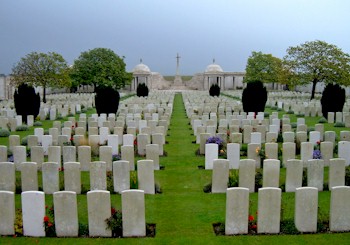|
|
| Home Topics Memorials Miscellany Transcripts References Family History Glossary Latest Beeston Blog About us | Site Search |
|
William Chalk, was born in Beeston in June 18842, the son of John William & Georgina (née Dunn) Chalk. His parents had married in Beeston in 1883 but, by 1891, John William and his family were living in Burton upon Trent, where Georgina had been born, and he was working as a railway labourer3. By about 1895, however, the family had moved back to Beeston and it was there that John William died, aged 46, in 1899. By 1901, William had started work as a lace maker. For some reason, he was boarding at 5 Union Street, Beeston4 even though his widowed mother and five of her younger children were living at 20 Humber Road South, Beeston5. Early in 19116, William married Fanny Williams with whom he had already had three children, one of whom having died as an infant7. He was then working as a telephone examiner, presumably at Ericssons, and he and his family were living as 'visitors' with his widowed mother and her other six children at 16 Humber Road, Beeston8. William Chalk joined the Northumberland Fusiliers in the early months of the war and was posted to the 2nd Battalion. This Battalion had been stationed in India at the outbreak of war but had arrived at back at Plymouth on 22 December 1914 and moved on to Winchester where it became part of 84th Brigate, 28th Division and then moved to the Western Front in January 1915. Private Chalk was posted to France on 18th May 19159 and would have arrived in time to have taken part in the Battle of Belleaard in the closing phase of the Second Battle of Ypres. During this battle, the British faced a huge German gas attack which forced a retreat which deepened the salient to the east of Ypres by over half a mile, to over 3 miles. It was a terrible experience, especially for newly arrived soldiers, such as Private Chalk. 28th Division, of which the 2nd Battalion was part (and, in turn, part of 84th Brigade) was one of the six British Divisions that took part in the major offensive at Loos in September 1915. This attack was preceded by a four day bombardment that saw the first use of poisoned gas by the British. The chlorine gas was a great disappointment. It was released at 5.50am, giving it forty minutes to do its work before the infantry attacked at 6.30. However, much of the gas either lingered in no mans land or drifted back over the British lines. Despite this setback, the first British assault was a success. The fighting subsided on September 28th with the British having retreated to their starting positions and then developed into the Action of the Hohenzollern Redoubt. Although war diaries do not appear to survive for 2nd Battalion Northumberland Fusiliers for this period, some accounts10 mention that 28th Division - of which the Battalion was part - made a failed attempt to recapture a position that had been captured and lost. It seems that it was during this period that Private Chalk was killed. During the Battle of Loos as a whole, British casualities totalled 59,247, including the deaths of three Divisional Commanders. Estimates of enemy losses vary, but the most common figure is a total of 25,000, less than half of the British figure. The autumn battles of 1915 all ended in a similar tale of Allied failure and heavy losses - 285,107 in the year in the Western Front alone. Sir John French took much of the blame for the failures and, in December, he was removed as commander of the British Expeditionary Force, replaced by Douglas Haig who held the post for the rest of the war. Among the British dead were Fergus Bowes-Lyon, brother of Elizabeth Bowes-Lyon (later the "Queen Mother") and John Kipling, the son of the author and poet Rudyard Kipling. Private Chalk was reported missing believed killed-in-action on 30th September 1915. His name is commemorated on the Loos Memorial, This commemorates over 20,000 officers and men who fell in the battle and have no known grave. Fanny Chalk, his widow, appears to have married Thomas Creighton in Nottingham in 1918 and died there in 1958, aged 7011. Footnotes 1The photograph of Loos Memorial is from the Commonwealth War Graves Commission website. (http://www.cwgc.org) 2Birth date recorded at his baptism on 19 April 1885 at Beeston Parish Church. His father was then described as a malster.Mbr> 31891 Census - 56 Oak Street, Burton-upon-Trent, Staffs - Piece 2204 Folio 90 4Beeston, 1901 Census, Piece 3153 Folio 151 5Beeston, 1901 Census, Piece 3153 Folio 162 6Basford Registration District, Q2/1911 - 7b 505 7The three children, Olive CHALK (b Q3/1907 - Basford Registration District : 7b 250 , died Q4/1907 - Basford Registration District : 7b 125), Jessie CHALK (b. Q1/1909 - Basford Registration District : 7b 269) and Elsie May WILLIAMS (b. Q3/1910 - Basford Registration District. Unusally the two earliest were recorded as 'CHALK' even though their apparent parents appear to have married after their birth and a later daughter was recorded with her mother's surname. The 1911 Census entry does record Fanny Chark as having three children (including one desceased) by the marriage. 81911 Census - Beeston - Piece 20430 RD 429 SD 3 ED 5 Schedule 135. 9The 'Qualifying Date' on medal card and 'Embarkation Date' in 1914-15 Star Roll for William Chalk, He was awarded the 1914-15 Star and the Victory and British Medals. His Service Record does not appear to have survived. 10See http://www.hellfirecorner.co.uk/Thornton/terriers1.htm 11Marriage - Nottingham Registration District, Q2/1918 - 7b 762. Death - Nottingham Registration District, Q3/1959 - 3c 234 |
|
|||||||||||
|
|
|||||||||||||
